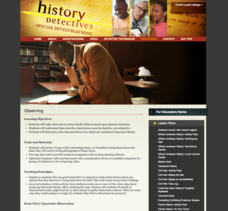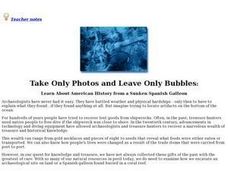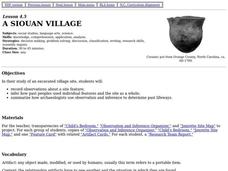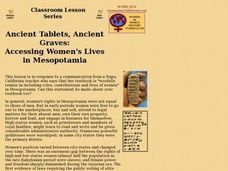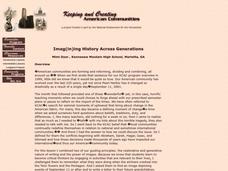Curated OER
Artifact Identification-What is it?
Students observe an artifact and make an inference about the artifact's purpose. They are going to role-play as archaeologists by using artifacts to hypothesize about the lives of past people.
Curated OER
Dr. Dirt's Archaeology Lab Artifact Analysis
Students simulate analyzing artifacts in archaeological lab by using real techniques that archaeologists use. Students practice measuring skills, drawing, writing, and brainstorming, and make inferences based on evidence.
Curated OER
Ecuadorian Highlands Lesson
Indigenous peoples resided in the highlands of Ecuador as far back as 5,000 B.C. To learn about the lives of these people, class pairs research the farming and the building methods, the arts and crafts, and the beliefs of the early...
Curated OER
What Do We Learn From the Repartiation of Alaska Native Artifacts?
Students observe and evaluate evidence of Alaska Native cultural symbols and artifacts. They research historical data from a variety of primary resources, including the Harriman expedition journals, related web sites, oral accounts,...
Curated OER
Blast from the Past
Students analyze historic artifacts to help gain an understanding of how the past has impacted their lives. They explain ways "design" can be both a noun and a verb. Students use internet resources to view and learn about artifacts that...
PBS
Predicting/Making a Hypothesis
Students analyze information from a variety of sources in order to create a hypothesis about the origin of an interesting family artifact.They create alternative hypotheses based upon available information to demonstrate that some...
PBS
Scavenger Hunt
Learners conduct field research of a historical site in order to discover a more complete understanding of a time period. They visit a site of historical significance and complete a scavenger hunt about the area.
PBS
Observation
Students study making scientific observations . They conduct a "field study" in their attic and make observations about their family artifacts based upon physical attributes. In addition, they determine what characteristics of an object...
Curated OER
social Studies: Yesterday, Today, and Tomorow
Sixth graders take an Internet trip back in time to explore ancient cultures. Working in teams, they assume the roles of theologian, cartographer, economist, political analyst, and anthropologist. The same groups then create time...
PBS
Written in Stone
Students explore history through a tour of a local cemetery. Students investigate tombstones for historical information, make stone rubbings, and use this secondary source reference to obtain primary sources.
Curated OER
Archaeologists Puzzle Pieces
Learners identify how archaeologists use typology to interpret artifacts. They interpret sample artifacts as if they discovered them.
Curated OER
Treasures of Ancient Egypt
Sixth graders create museum displays about Egyptian life. Their exhibits include information about ancient Egypt's religion, economics, government, and customs. Their museum items resemble actual artifacts they have researched.
Curated OER
Dear Me
Students take a classroom "gallery walk" memorializing 9/11. As a class, they read and discuss the article "A Day to Clear the View, and Remember." Then, they write letters focusing on events that have made them want to alter their life...
Curated OER
Sultan's Lost Treasure
Students view a video clip about a sultan's lost treasure. They examine artifacts and determine their characteristics. They complete a worksheet to end the instructional activity.
Curated OER
Forensic Examination of Artifacts: The Mystery of Meriwether Lewis' Death
Students role play the position of a scientist to gather information on Meriwether Lewis' death. They discover what he did after the famous expedition and how centuries affect the study of a body. They share their information with the...
Curated OER
Can You Dig It?
Students use a mock archaeological site to dig up artifacts. They read an article about artifacts found in Syria. They develop a list of artifacts that are related to specific sites in the community. They create an exhibition of these...
Curated OER
Ancient Civilizations
Sixth graders, in groups, research the culture of an ancient civilization. They use the Internet to locate artifacts that illustrate different elements of culture, write a description and analysis of each piece and present their work to...
Curated OER
Back From the Future
Students pose as archaeologists, famous for their scholarly excavations, writing, and lectures about ancient cultures and are invited back to the 20thy century from the year 3000 to explore an archaeological sit, their classroom.
Curated OER
Take Only Photos and Leave Only Bubbles: Learn About American History from a Sunken Spanish Galleon
Students simulate the research process of investigating a shipwreck. In small groups, they conduct Internet research, and develop and write a proposal for excavation of the archaeological site.
Curated OER
A Siouan Village
Fourth graders examine the artifacts obtained from an excavated Siouan village site. They make inferences about the people who once lived there based on the artifacts and complete a Research Team Report.
Curated OER
In Celebration of the Silk Road
Sixth graders explore the ancient trade routes of the Silk Road with a focus on a province in China to identify artifacts and research how these items arrived in the city of Turpan.
Curated OER
Ancient Tablets, Ancient Graves: Accessing Women's Lives in Mesopotamia
High schoolers explore the role of women in ancient Mesopotamia. Several excerpts from the Mesopotamian cuneiform tablets and artifacts are analyzed to determine the treatment, rights, and powers of women in this era.
Curated OER
Egypt's golden Empire
Learners explore many of the key scientific and technological contributions made by the ancient Egyptians. Researched data is presented to the entire group.
Curated OER
Imag(in)ing History Across Generations
Young scholars find an image depicting events of September 11 or after and write a letter to their future grandchldren explaining the image and why those chose to preserve it for them.









